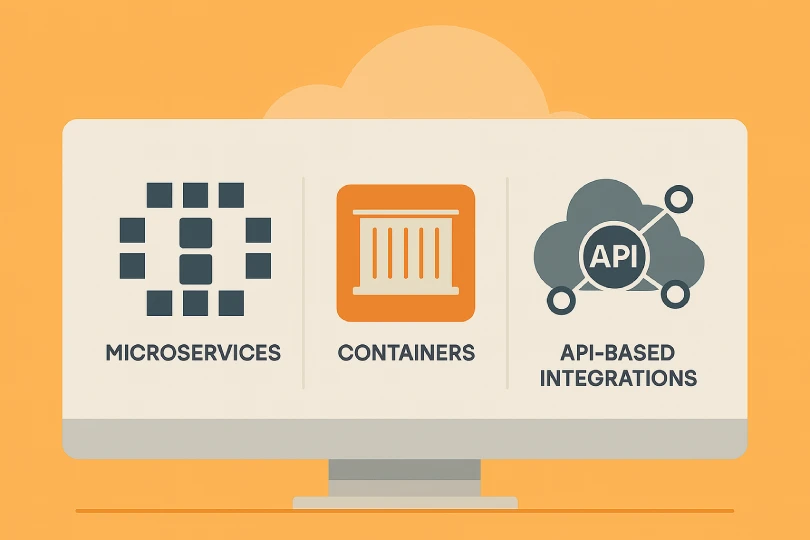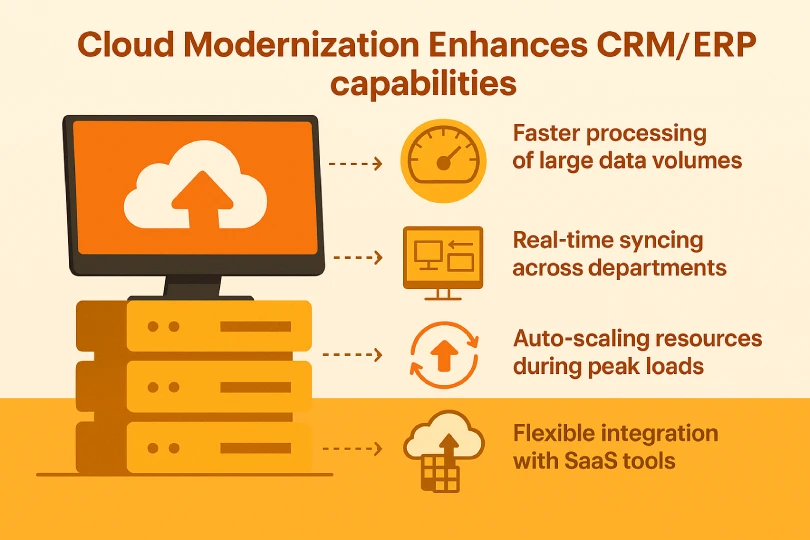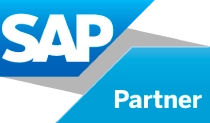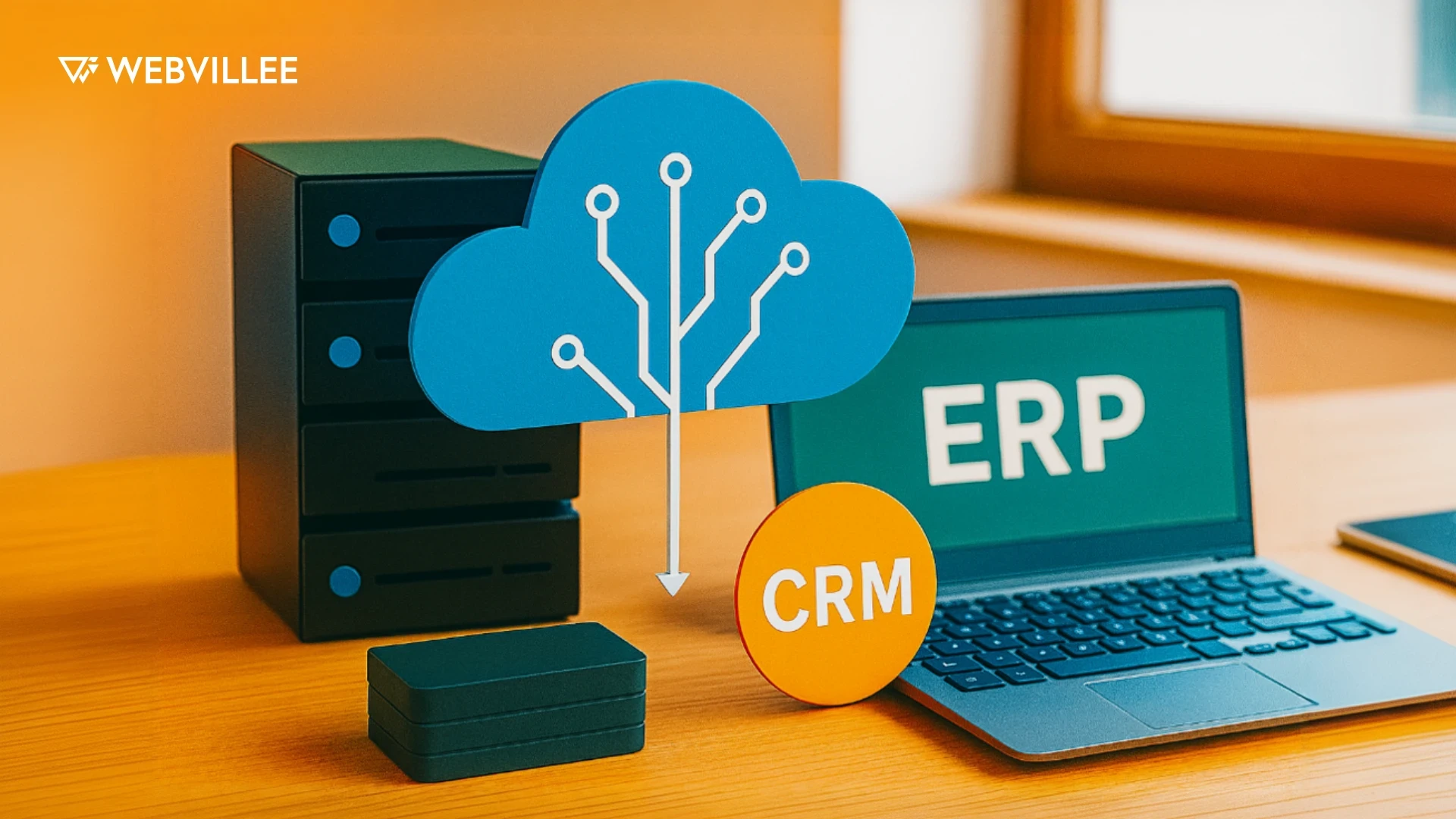In 2025, CRM and ERP scalability is no longer a technical nice-to-have. It is a core requirement for businesses aiming to grow, serve faster, and compete smarter.
Legacy systems often limit your ability to:
- Integrate new tools and data sources
- Support remote or hybrid operations
- Innovate quickly with changing customer needs
They become bottlenecks rather than enablers. That is where cloud modernization steps in.
By moving core systems like CRM and ERP to modern cloud architectures, businesses can:
- Scale up or down without downtime
- Improve speed, reliability, and access across teams
- Enable real-time collaboration and visibility
This blog unpacks how cloud modernization enhances CRM and ERP scalability, what trends are shaping this shift, and how companies can make it work without disruption.
What is Cloud Modernization?
When businesses ask what is cloud modernization, they’re usually thinking beyond just moving files to the cloud. It’s not about hosting old systems on a new platform. It’s about upgrading how software works at its core to better support speed, scale, and flexibility.
Cloud modernization involves rethinking your software architecture to take advantage of modern cloud-native features.
Here are the key components that define it:
- Microservices architecture
Breaks software into smaller, independent units for faster updates and less downtime. - Containers
Packages software and its dependencies into one unit so it can run reliably across different cloud environments. - API-based integrations
Makes it easier to connect systems and share data across platforms securely and efficiently.
Unlike the basic lift-and-shift model, which simply moves your old infrastructure to cloud servers, modernization re-engineers applications to perform better, scale automatically, and support innovation.
If you’re relying on legacy systems that feel outdated or slow to adapt, cloud modernization is the step that makes your CRM and ERP systems more responsive to today’s business demands.

Why Traditional CRM/ERP Systems Struggle to Scale
As your business grows, your systems need to grow with it. But most traditional platforms hit a wall when it comes to CRM and ERP scalability. These older systems weren’t built to handle today’s rapid data growth, remote teams, or integration-heavy ecosystems.
Here’s why they often fall short:
- Data silos
Information gets trapped in separate systems. Sales, support, and operations work in isolation, which slows decision-making. - Complex upgrades
Updating a traditional ERP system can take months. It often requires heavy downtime, added costs, and vendor dependencies. - High infrastructure costs
On-premise systems require physical servers, backups, and constant IT maintenance, which quickly becomes expensive. - Poor mobile access or user experience
Legacy tools are usually desktop-first, with outdated interfaces that don’t adapt well to remote or mobile work.
These issues are more than technical frustrations. They directly impact customer service, response times, and internal efficiency. Without a path to scale, your CRM and ERP can become blockers rather than enablers.
How Cloud Modernization Enhances CRM/ERP Capabilities
Legacy systems struggle to keep up with growing business demands. Cloud modernization solves this by making your CRM and ERP tools faster, more flexible, and ready to scale as you grow.
Here’s how it boosts CRM and ERP scalability:
- Faster processing of large data volumes
Cloud platforms are built for speed. They can handle massive datasets without slowing down operations. - Real-time syncing across departments
Sales, support, and finance teams can all work from the same live data, reducing delays and improving collaboration. - Auto-scaling resources during peak loads
Whether it’s the end of a sales quarter or a product launch, cloud infrastructure adjusts automatically so performance stays smooth. - Flexible integration with SaaS tools
Need to plug in a new analytics or marketing tool? Cloud-based systems are built to connect easily, without the need for custom hacks.
With these upgrades, businesses unlock scalable CRM and ERP systems that evolve with changing goals. Cloud modernization turns rigid software into agile, responsive platforms, giving you a strong foundation for smarter decisions and faster execution.

Key Benefits for Businesses
Adopting cloud modernization is not just about upgrading technology. It brings practical, long-term value to your business operations. As CRM and ERP systems become central to decision-making, scalability and performance matter more than ever.
Here are four key benefits businesses can expect:
- Lower long-term costs
Traditional systems come with hidden maintenance, upgrade, and infrastructure expenses. Cloud-based solutions offer flexible pricing, reduced hardware needs, and less downtime. - Improved decision-making through analytics
With real-time data from multiple departments flowing through a unified system, insights are faster and more accurate. Better data leads to better business choices. - Faster feature rollouts
Cloud platforms make it easier to test, launch, and iterate on new features. No need for lengthy deployments or heavy downtime. - Better disaster recovery and uptime
Built-in redundancy, automated backups, and global access mean your systems stay online even during disruptions.
With cloud modernization, companies move from rigid, reactive systems to agile, proactive platforms. This shift supports not just IT teams, but every business unit aiming to grow efficiently and respond to change faster.
Webvillee’s Approach to Modern CRM/ERP Systems
At Webvillee, we approach CRM and ERP transformation with a clear focus on scalability, real-time collaboration, and long-term business fit. Our team works closely with clients to design systems that evolve with their operations, not against them.
Whether it’s a retail company struggling with siloed inventory or a manufacturing firm needing unified vendor management, our CRM and ERP service is built to address the real-world gaps that generic solutions often miss.
Here’s what sets us apart:
- Tailored cloud-first architecture based on your growth plans
- Seamless integration with third-party tools and legacy systems
- High security and compliance support across industries
- Post-deployment optimization and support
Get in Touch with our team to explore how we can build CRM and ERP platforms that are ready for your next stage of growth.

